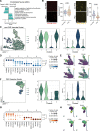Single-Nuclei RNA-Sequencing of the Gastrocnemius Muscle in Peripheral Artery Disease
- PMID: 37823262
- PMCID: PMC10599805
- DOI: 10.1161/CIRCRESAHA.123.323161
Single-Nuclei RNA-Sequencing of the Gastrocnemius Muscle in Peripheral Artery Disease
Abstract
Background: Lower extremity peripheral artery disease (PAD) is a growing epidemic with limited effective treatment options. Here, we provide a single-nuclei atlas of PAD limb muscle to facilitate a better understanding of the composition of cells and transcriptional differences that comprise the diseased limb muscle.
Methods: We obtained gastrocnemius muscle specimens from 20 patients with PAD and 12 non-PAD controls. Nuclei were isolated and single-nuclei RNA-sequencing was performed. The composition of nuclei was characterized by iterative clustering via principal component analysis, differential expression analysis, and the use of known marker genes. Bioinformatics analysis was performed to determine differences in gene expression between PAD and non-PAD nuclei, as well as subsequent analysis of intercellular signaling networks. Additional histological analyses of muscle specimens accompany the single-nuclei RNA-sequencing atlas.
Results: Single-nuclei RNA-sequencing analysis indicated a fiber type shift with patients with PAD having fewer type I (slow/oxidative) and more type II (fast/glycolytic) myonuclei compared with non-PAD, which was confirmed using immunostaining of muscle specimens. Myonuclei from PAD displayed global upregulation of genes involved in stress response, autophagy, hypoxia, and atrophy. Subclustering of myonuclei also identified populations that were unique to PAD muscle characterized by metabolic dysregulation. PAD muscles also displayed unique transcriptional profiles and increased diversity of transcriptomes in muscle stem cells, regenerating myonuclei, and fibro-adipogenic progenitor cells. Analysis of intercellular communication networks revealed fibro-adipogenic progenitors as a major signaling hub in PAD muscle, as well as deficiencies in angiogenic and bone morphogenetic protein signaling which may contribute to poor limb function in PAD.
Conclusions: This reference single-nuclei RNA-sequencing atlas provides a comprehensive analysis of the cell composition, transcriptional signature, and intercellular communication pathways that are altered in the PAD condition.
Keywords: ischemia; lower extremity; peripheral arterial disease; peripheral vascular diseases; transcriptome.
Conflict of interest statement
Figures







References
-
- Criqui MH, Aboyans V. Epidemiology of peripheral artery disease. Circ Res. 2015;116:1509–1526. doi: 10.1161/CIRCRESAHA.116.303849 - PubMed
-
- Criqui MH, Matsushita K, Aboyans V, Hess CN, Hicks CW, Kwan TW, McDermott MM, Misra S, Ujueta F, Epi AHAC, et al. . Lower extremity peripheral artery disease: contemporary epidemiology, management gaps, and future directions: a scientific statement from the American Heart Association. Circulation. 2021;144:E193–E193. doi: 10.1161/Cir.0000000000001019 - PMC - PubMed
Publication types
MeSH terms
Substances
Grants and funding
LinkOut - more resources
Full Text Sources
Medical
Molecular Biology Databases

